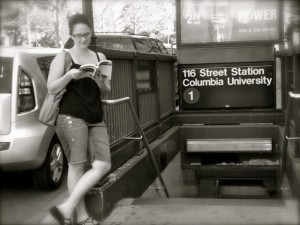I am a digital native, don’t get me wrong I wouldn’t consider myself a technology genius or anything like that. But, at the same time I would struggle to get through the day without my fingers on my laptop, iphone, and ipod (if you’re wondering if you should buy a Mac the answer is yes).
This past year in my classroom I experimented a lot with video. I used a Kodak PlaySport video camera (see flip camera) to record and analyze my own teaching. I let the kids make short films and projects on the camera. I even helped other staff members make their own video projects using the camera, and then I edited the footage using iMovie. Seriously, I love Mac products because they make it all so easy and accessible. I also used movies for sub plans; this kept the kids on track and made the sub’s day a little easier! Some days, I thought they liked watching me on video more than the real me.
At Columbia this year, I realized that I wasn’t the only one who was technology obsessed. Practically everyone was carrying around an iPad; the jealousy was killing me. I do love new toys, but this one would certainly have power in the classroom, especially if it had its own 3G server. Think about it— we could Facechat on the big screen with Miguel in Africia, and Michele in Manhattan, and Tash in Australia, and Mom in Media, without any server firewalls telling us to arrange it through the tech department. Imagine the wealth of information that we could gain from five minutes of live conversation outside the walls of our classroom! Maybe we could even get some authors on there . . . oh iPad, you will find a happy home in our classroom!
I have a Kindle; this summer I’ve become pretty good friends with this beautiful piece of technology. I’ve heard plenty of adults complain about not being able to hold a “real book” or something like that, but I teach middle schoolers— and umm Kindles are cool. Anyway, I plan on bringing in the Kindle this year; my reluctant readers won’t know what hit them when I let them use that little book to read, take notes and oh my favorite feature—highlight!
Don’t even get me started on the wonders of a smart phone. I held out on getting one for so long because I didn’t want to pay that much for cell phone service— stupid decision, it is 100% worth the $80 cell phone bill. My favorite new application is Merriam-Webster Dictionary. I know it sounds dorky, but really it’s not. Sure, it does what you would expect, it defines words, but if you want you can just say the word you want to look up and it will spell/define it for you. For example, yesterday no matter how hard I tried, I couldn’t figure out how to spell amateur correctly. I picked up my phone, said the word, and my phone spelled it for me. Can I get a hallelujah for less time wasted? And for the kids that will regain confidence and speed when I let them use my phone/ their phone for this free app!
There’s more, there’s so much more— I mean blogs, google docs, document cameras, smart boards, (the Wii???)— and our kids?They’re pretty good at using them all. I’m not bad at it either, but I’m totally willing to look stupid once in awhile as I learn. If you work in my building and want to see any of these fun things in action this year, come on down. If you’re just reading for fun, comment and ask questions, try things out yourself, let me know what I’m missing. You don’t have to be a technology native to realize and use these tools in your classroom.
